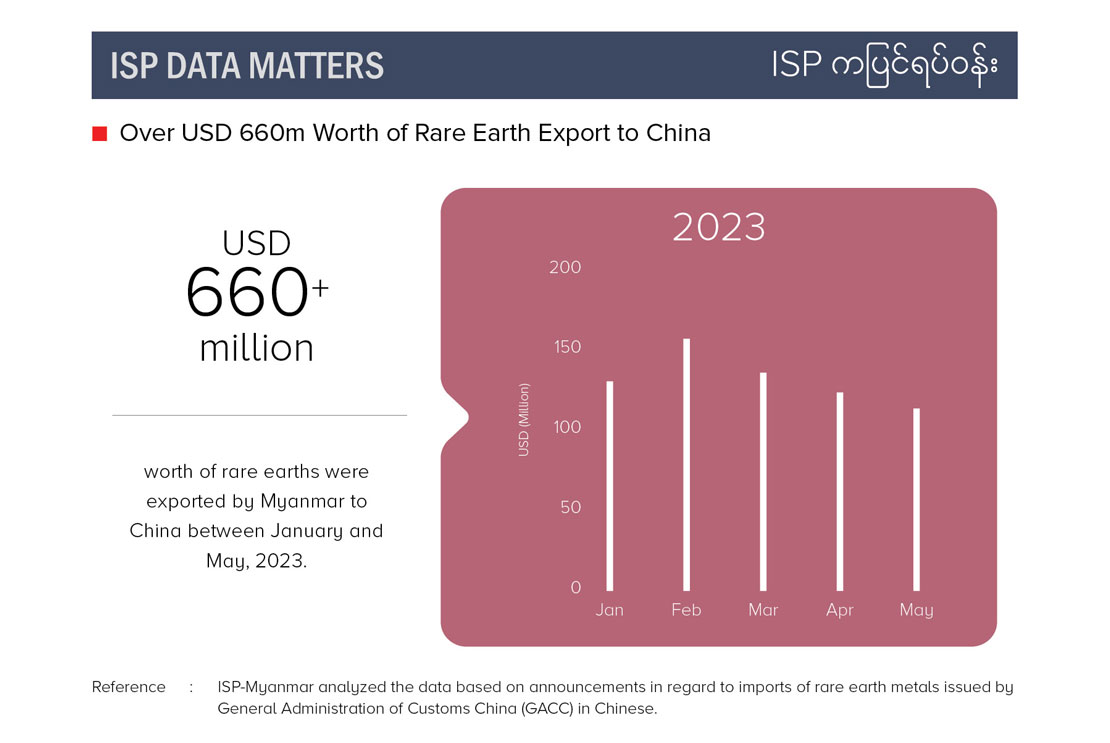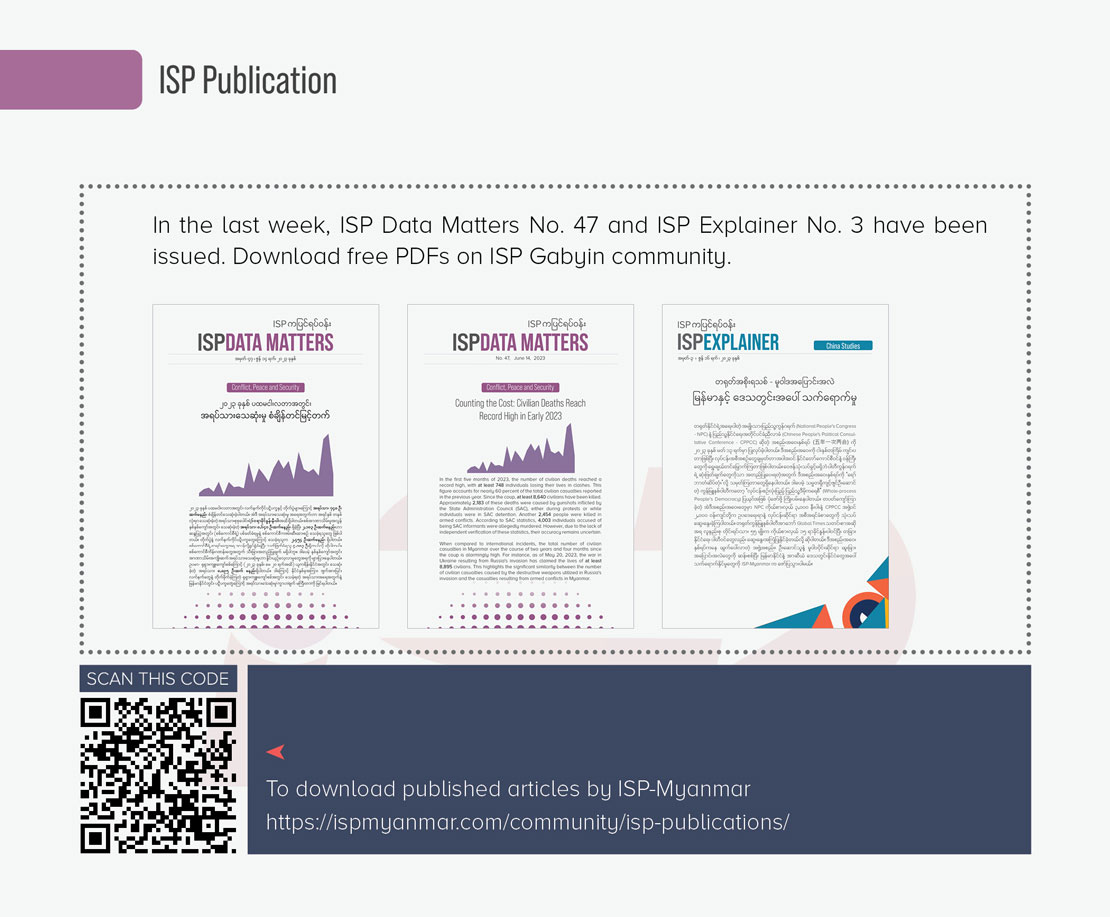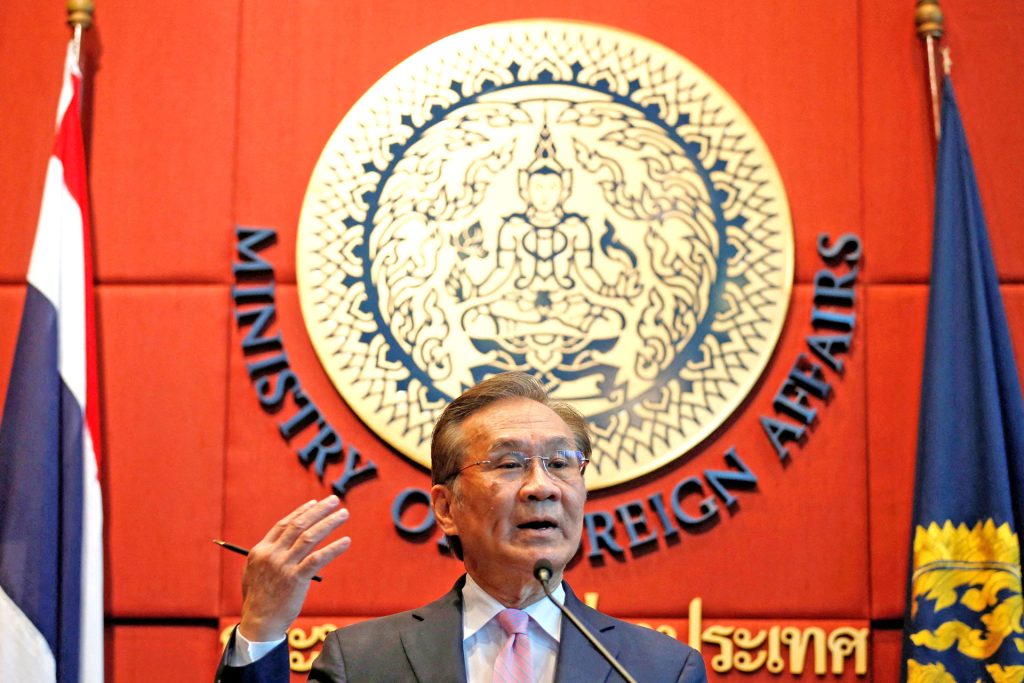Insight Email No. 17
This week’s ISP Insight Email focuses on the informal meeting on Myanmar in Pattaya, organized by the Thai caretaker government. Readers will also find a discussion of the possibility that SAC officials held a secret meeting with Daw Aung San Suu Kyi amid the ongoing concern that the media information space is becoming ever more conducive to rumors, fake news, misinformation, and disinformation. This week’s bulletin also examines the continued rise of rare earths mining in Myanmar despite community opposition, the introduction of a book on Karenni national history by veteran politician Khau Marko Ban, and an examination of the developing trend of regional groupings and fora among Myanmar opposition groups, as initiated by the ‘Sagaing Forum.’

∎ Key takeaways
1. Pattaya ‘Neighborhood Diplomacy’ Meeting
Thailand caretaker government’s Foreign Minister Mr. Don Pramudwinai sent out invitations for an informal talk on Myanmar to be held at a meeting in Pattaya on June 19. The foreign ministers of Indonesia, Singapore, and Malaysia all declined to attend the meeting. But SAC Foreign Minister, U Than Swe, and delegates from China and India participated in the meeting. Mr. Don claimed ‘progress’ in talks on Myanmar with the Bangkok Post reporting his response to the meeting: “Everyone was happy with today’s meeting. We explored many issues, including the current situation along the border, organized crime scams, and other transnational crimes.”
The meeting was billed as ‘informal’ but it represents an apparent division within ASEAN. Ms. Retno L.P. Marsudi, Foreign Minister of Indonesia, which currently holds the 2023 annually rotating ASEAN chair, retorted strongly to the invitation, stating that only as recently as last month the 42nd ASEAN Summit had discussed the situation in Myanmar, without arriving at any consensus to either re-engage or develop new approaches to the Myanmar issue. Jakarta is also already establishing an ASEAN special envoy on Myanmar to tackle the Myanmar crisis. Ms. Marsudi did not suggest that Thailand had crossed a line on ASEAN unity, but did ask for support to continue on ASEAN’s current path. Media also questioned Thailand’s rush to call the meeting given the timing after recent elections with a caretaker government in power.
Thailand and Myanmar share a long border and there are many shared issues to deal with, such as transborder human trafficking, cracking down on the illicit drugs trade, arms smuggling, energy, and other investment and economic issues. In light of this relationship Thailand cannot afford to standby as only an observer, but has a proactive role to play in the relationship. However the bilateral relationship between Myanmar and Thailand should be based on peace and in support of the democratic will of the people of Myanmar. It is also interesting to observe the recent development of ‘Neighborhood Diplomacy’ initiated by China juxtaposed with the new trend of ‘ASEAN Minus’ on the Myanmar issue.
The so-called Track 1.5 meeting on Myanma was held with semi-government officials and experts in Thialnd on December 22, 2022, and SAC Foreign Minister, Wunna Maung Lwin, and International Cooperation Minister, Ko Ko Hlaing, Minister of Investment and Foreign Economic Relations, Kan Zaw all participated. Another similar meeting was organized by the Indian government in the last week of April 2023. The third Track 1.5 meeting will be hosted by Laos. London-based Economist Intelligence Unit (EIU) considered the Pattaya meeting a splintered engagement with Myanmar by different ASEAN states which could prove counterproductive to resolving the political crisis in Myanmar. EIU sources said that China’s participation in the meeting was quite assertive on the grounds of Myanmar’s sovereignty. An upcoming and related development is ASEAN’s planned joint navy exercises in September, which aim to reassert ASEAN’s symbolic centrality and neutrality, organized by the Indonesian Navy. But sources said that both Cambodia and Myanmar, two of China’s closest allies in the region, have declined to participate.
2. Mystery over possible SAC meeting with Daw Aung San Suu Kyi
On June 12, 2023, media reported that a meeting had taken place between SAC delegates and imprisoned leader Daw Aung San Suu Kyi. This was reported firstly by Irrawaddy News and later by Radio Free Asia (RFA)Burmese section. Lt-Gen. Yar Pyae and retired Lt-Gen. Khin Zaw Oo, who in combination lead the junta’s peace dialogue, allegedly went to Naypyitaw prison on May 27 and June 4 to meet with Daw Aung San Suu Kyi. Much speculation followed the news. A local media outlet CNI though later reported that the news was incorrect and the BBC-Burmese section then interviewed SAC spokesperson Gen. Zaw Min Htun who stated that no such meeting had taken place. Subsequently, the National League for Democracy (NLD) released a statement on June 19, on the occasion of Daw Aung San Suu Kyi’s birthday stating that “Daw Aung San Suu Kyi is the key individual who must not be left out while resolving Myanmar’s problem…. There will be no way out unless meeting with Daw Aung San Suu Kyi, for the political problems caused by the military coup.”
The mystery of whether Daw Aung San Suu Kyi met with SAC delegates is notable for the role, credibility, and freedom of the media in Myanmar. Media freedom has been deteriorating since the coup and in particular, crackdowns have taken place against independent media in Myanmar. The information ecology has now totally collapsed and as a consequence, an environment that can nurture independent and reliable media is dying, resulting in a mushrooming of rumors, fake news, misinformation, and disinformation. In the case of the report about the meeting with Daw Aung San Suu Kyi, SAC officials did not make themselves available for response to the media. This is in keeping with the noticeable trend that the SAC information team have failed to organize regular press briefings. SAC generals, as the current executive power in Myanmar, have the unique ability to establish the record, to counter any incorrect information, but for unknown reasons they remain reluctant to talk to the media. Mainstream media remain starved of reliable news sources and make do with weakened references. Many renowned media outlets neglect to correct their mistakenly printed information. At the same time, unreliable information from social media has mushroomed and is contaminating the media ecosystem. This particular case of an unconfirmed clandestine meeting between the SAC and Daw Aung San Suu Kyi indicates that Myanmar needs an independent, reliable, and vibrant media environment.

3. Inexorable Rise of Rare Earths Mining
Kachin State is home to a boom in ‘illegal’ rare earths mining for export. Many local communities though have opposed the mining developments as they could impact the local environment and locals’ livelihoods. But mining interests have not stopped and are, rather, incessantly advancing. The ethnic armed group Kachin Independence Organization (KIO/KIA) has now themselves started rare earths mining in Chipwi Township, which is under the command of the New Democratic Army-Kachin (NDA-K), which officially converted to the Myanmar military-controlled Border Guard Forces (BGF).
Since May 2023, a Wa company conducted exploration and mining of rare earths in Hpare village, within KIO Brigade 7 controlled area, with local residents raising objections and sending complaints to the KIO. KIO officials though have threatened locals with arrest if they continue to voice opposition to the mining project. Local residents have continued to protest against KIO development of rare earths mining, but production continues to operate with little consideration for local interests. Tensions have continued to mount between local residents and KIO officials. In March, a conflict erupted between local residents of Dengsingpar village of Mansi Township and a Chinese company that is conducting rare earths mining in the area. There are unconfirmed reports that this action resulted in the local KIO authority temporarily suspending the project. According to other reports there are also rare earth mining sites in Mai Ja Yang of Momauk Township.
This ‘illegal’ Kachin State rare earths production and export trade to China has been incessantly increasing since the military coup. According to the General Administration of Customs of China (GACC) statistics, rare earths exports from Myanmar to China were valued at almost USD 2 billion in the post-coup period. SAC and KIO have both officially denied the official existence of rare earths mining projects for export to neighboring countries, but the evidence shows otherwise.

Alongside this increased resource extraction are tremendously negative impacts on the environment, social factors, human rights, and livelihoods of locals. As the rule of law has weakened since the military coup, the extraction of natural resources has increased dramatically and many conflict parties increasingly depend on the ‘resource economy’ for fueling the war. This acts as a driver, advancing the rare earths mining industry. Rare earths mining is also raising more tension and conflict between locals alienated from the industry, and officials who are the main beneficiaries. The negative social and environmental impacts from rare earths extraction are unlikely to stop with the local Kachin communities, but will also spread to the whole population of Myanmar. Chipwi Township, one of the most prominent places for rare earths mining, is located on the Maykha (N’mai) River, one of main sources of the Irrawaddy River. Waste from rare earths production processes will flow downstream, emptying into the Irrawaddy.

∎ Trends to be watched
Regional Groupings and Fora
The first Sagaing Regional Forum was held on May 30-31, 2023. The significance of the forum is that the Sagaing Region was the strongest and most resilient resistance center in the ‘Spring Revolution’ and it was thirty armed resistance groups who initiated the meeting. Delegates from 173 resistance groups from 28 Townships reportedly participated in the meeting along with 31 observers. Many resistance groups from other ethnic and geographic regions also sent well-intentioned messages to the forum.
The Sagaing Forum sits within the participants’ long-term vision of the Sagaing Region becoming a future federal unit of the Union of Myanmar. The forum aimed to form a ‘consultative council’ and as part of its short-term objectives, sought better cooperation and collaboration of political and military functions among its constituent forces (See ISP-Myanmar’s Insight Email No. 16) The Sagaing Forum was particularly significant due to its organic development, representing a bottom-up approach, full inclusivity, collective decision-making, and the representation of local voices.
Following the Sagaing Forum, on June 12 the Karenni National Progressive Party (KNPP) announced an Interim Executive Council (IEC) of the Karenni State, composed of six leaders. The IEC aims to foster collaboration among the many resistance groups within the Karenni State and to coordinate administration through the interim period. It is reported that both Chin and Karen states could form similar interim councils. At the same time, news appeared that resistance groups from Tanintharyi and Ayeyarwady Regions could organize regional fora to form consultative councils of their own. Groups from Dawei province also organized an online meeting on June 21 in order to establish a political leadership organ for the province.
The unity of the various resistance groups is a political advantage and should be welcomed. However, there is seemingly no relationship between the newly formed councils and any formal body of central leadership, and no mechanism for the councils to work with central-level leading body. Building federal units in parallel and pursuing better collaboration within each unit is a positive development, but it remains questionable how these groups can initiate Union-level negotiation or to establish a common vision for the future of the federal Union of Myanmar.
It is also noticeable that tensions remain between the local PDFs and NLD/ NUG subordinate forces in Sagaing Region. On the other hand, unless there is greater development of democratic accountability at the unit level, i.e. through regular democratic elections, protection of democratic rights, freedom of speech, and the fostering of a vibrant civil society, then the tendency of regional executive councils could lean more toward local warlords, regional leaders, and the primacy of brute force in the absence of law.

Considering the new development of a federal ‘unit’ of the Union is virtuous, but runs the risk of clouding the vision of the greater Union. On the other hand, the military junta should be quite happy with the move. The agenda of “taking care of your locality, shouldering arms, establishing regional ceasefires, and working for local development” was the mantra of the previous junta’s ceasefire with the ethnic armed groups in the 1990s. Through the federal unit council approach, national problems can be compartmentalized regionally and solved according to local interests. The junta could then engage with each particular armed resistance group on the basis of business interests and revive the ‘crony capitalism’ of the past. The future development of regional groupings and fora among armed resistance groups is worth watching.
∎ What ISP is reading?
Khau Marko Ban’s the ‘Karenni National History’
Khau Marko Ban (a.k.a) Bhu Ban. (May 2023). Karenni National History. (Place and Publisher: Unknown). 100 pages.
Just last week, ISP-Myanmar found a book on ‘Karenni national history’. The author is a veteran ethnic politician who served as the Minister of Federal Affairs in the now-defunct exiled National Coalition Government of the Union of Burma (NCGUB). He has written many books on ethnic politics and federalist issues in Myanmar.
In regards to Karenni national history, the Transnational Institute (TNI)’s 2018 publication “From War to Peace in Kayah (Karenni) State: A Land at the Crossroads in Myanmar” is readily available. One of the authors of that report is a renowned historian of Myanmar, Martin Smith. In addition, Khun Be Du and Naw Phaw War of Loikaw-based LAIN Technical Support Group also researched and wrote “Karenni Unity and Challenges” (published in July 2020), which concerns the repeated attempts at mediation and reconciliation among different ethnic groups within the Karenni State since independence. But, Be Du, himself is now fighting the junta as a chairman of the newly emerging Karenni Nationalities Defence Force (KNDF). Nevertheless, it is encouraging that ethnic politicians are writing books on their points of view and with the use of historical documents.
In Khau Marko Ban’s writing, he argues “in Karenni nationality, the seven tribes Kayah, Kayan, Bre-Kayaw, Yintale, Manu-Manau-Kawyae, Geba, Paku, constitute an ethnicity. … If we are going to write the history of Karenni, it shall cover the development of all tribes of Karenni.” The book’s chapters cover topics such as the origin of the Karenni nation descending from prehistoric times, the formation of a nation, the economy of the past Karenni State, and attempts to unify as a Karenni State.
Khau Marko Ban’s book though only briefly covers the modern political history of the Karenni state, as more than 60 of the book’s 100 pages are devoted to descriptions of pre-historic tribal development, and the descent from the Mongolia highlands. He spends only a few pages on early colonial events and the political history of the Karenni lands after Myanmar’s independence in 1948.
Recently, some interest groups organized the ‘148 th anniversary of Karenni National Day’, dated from June 21, 1875, recalling the event when Sir Thomas Douglas Forsyth of the British Empire and Kinwun Mingyi U Kaung, agent of the King of Burma signed an agreement to recognize the Karenni state’s sovereignty and independence during British colonial rule in Myanmar. Khau Marko Ban mentions this history, but he covers very little of the political history of the Karenni State after Myanmar’s independence. If you wish to read more on modern Karenni political history, the TNI report, spaning 222 pages, is a good introduction to the topic.


